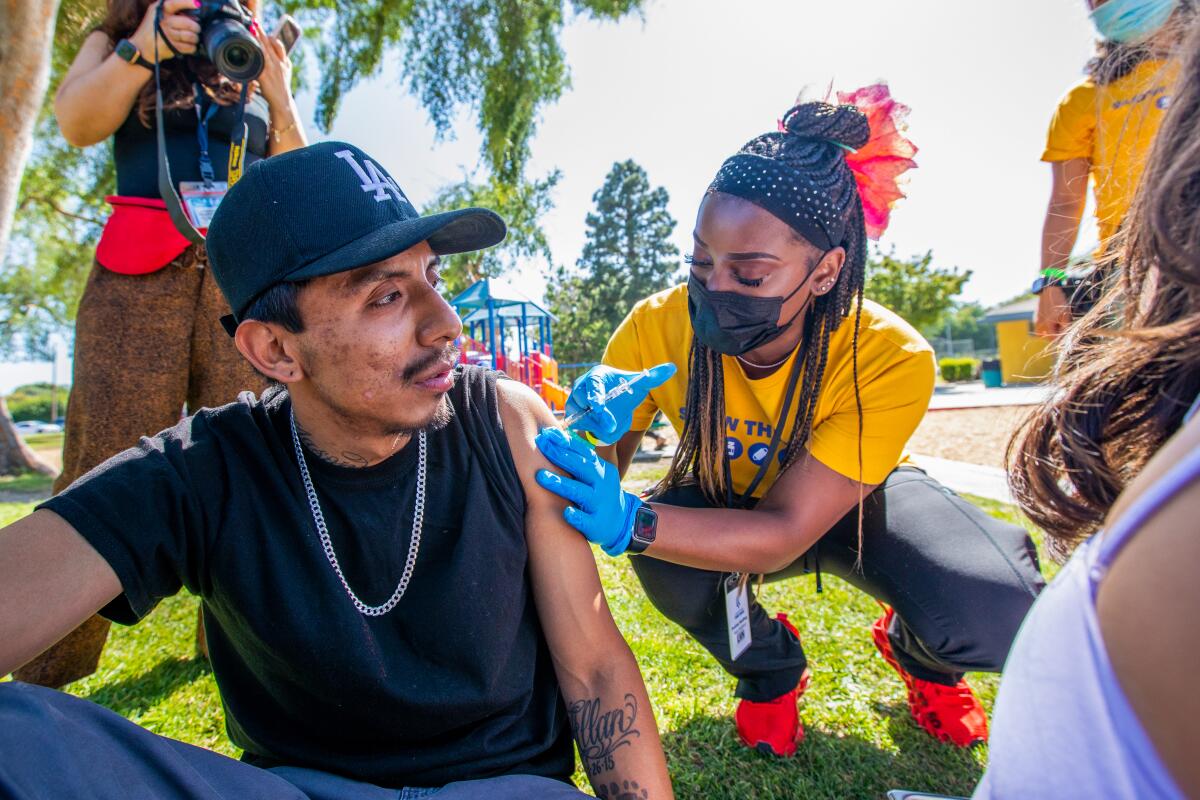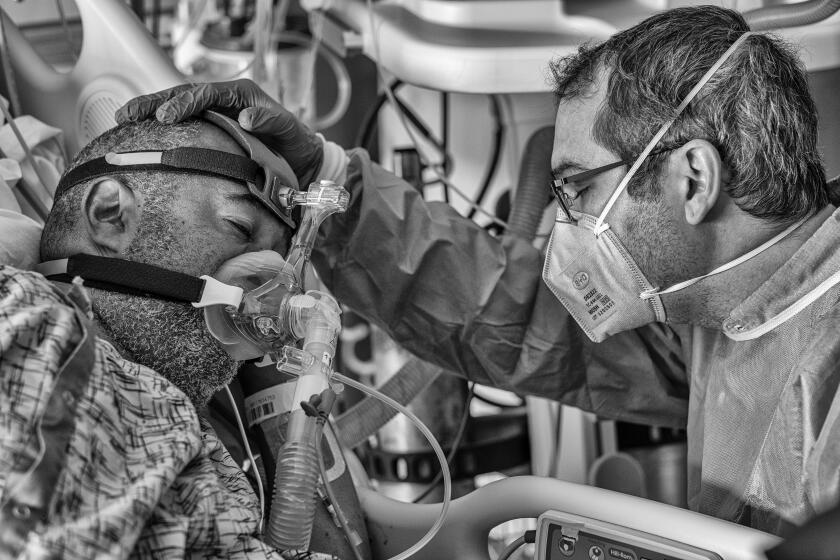L.A. coronavirus hospitalizations start rising again; officials urge mask-wearing

Los Angeles County’s coronavirus-positive hospitalizations are rising again, causing health officials to urge residents to put masks back on if they have stopped doing so.
L.A. County already requires mask-wearing on public transit and at its airports, and Public Health Director Barbara Ferrer urged residents Monday to wear masks inside schools, stores and workplaces.
“This would give us a chance at slowing down spread while we continue to increase the numbers of residents and workers up to date with their vaccinations, since vaccines give us the most protection from severe illness and death,” Ferrer said in a statement.
Ferrer has strongly recommended indoor mask use ever since the L.A. County Department of Public Health ended its 7½-month universal mask order on March 4. But Ferrer’s message seemed to take a more urgent tone Monday, with coronavirus-positive hospitalizations rising 29% in the last week, to 312 as of Sunday.
How to process the pandemic death toll? For one hospital chaplain, it means also remembering relatives left behind.
The 29% week-over-week increase in coronavirus-positive hospitalizations was the highest weekly percentage increase in L.A. County since mid-January, after the Omicron surge peaked.
Still, the numbers of coronavirus-positive hospitalizations remain low. Daily reported COVID-19 deaths in L.A. County also remain low, at about eight deaths a day.
“While it is reassuring to note the relatively low rates of hospitalizations and deaths, getting infected for many is still very risky and something to be avoided wherever possible,” Ferrer said. “As has been true throughout the pandemic, keeping others safe often requires that many of us align with sensible safety measures.”
The numbers follow increasing coronavirus cases, which rose to more than 2,900 cases a day, a rate not seen since late February. That’s up 16% over the prior week’s rate of about 2,500 cases a day.
The latest case rate is equivalent to 204 cases a week for every 100,000 residents, according to a Times analysis. That means L.A. County is on track to be officially moved from having a low COVID-19 community level to a medium level by the U.S. Centers for Disease Control and Prevention soon. A county with 200 or more cases a week for every 100,000 residents is automatically considered an area at a medium COVID-19 community level.
At a medium COVID-19 community level, the CDC recommends that people vulnerable to severe illness from COVID-19 consider wearing masks. It’s more lax guidance than that issued by L.A. County and California health officials, who have strongly recommended continued use of masks in indoor public settings since mandatory mask orders ended.
L.A. County is still far from hitting the thresholds for a high COVID-19 community level, in which the CDC recommends universal mask use, and in which county health officials have said they’d reimplement a universal mask order in indoor public settings.
L.A. County’s rate of new weekly coronavirus-positive hospitalizations is less than one-third of the rate needed to hit the threshold for a high COVID-19 community level, according to CDC data reported on Thursday.
Factors in the increase in viral transmission have been decreased use of masks and the introduction of even more contagious Omicron subvariants. The Omicron subvariant BA.2 is more transmissible than the earliest Omicron version that dominated in the winter, BA.1. BA.2 now accounts for about 85% of analyzed coronavirus specimens.
In addition, there are additional Omicron subvariants that are believed to be more contagious than BA.2 that are being seen more often.
BA.2.12.1 now accounts for about 12% of analyzed coronavirus samples in L.A. County, as of mid-April, and BA.2.3 and its relatives account for about 9% of samples.
“With the proliferation of highly infectious sub-lineages of Omicron, it is easier for infected individuals to unknowingly pass along the virus, resulting in many of us experiencing more spread associated with our gatherings and travel,” Ferrer said.
The nation is in the grips of a new wave related to the Omicron subvariants BA.2 and BA.2.12.1, Dr. Eric Topol, director of the Scripps Research Translational Institute in La Jolla, wrote in a blog post Sunday.
But the official report of 90,000 coronavirus cases a day nationally — double the rate from three weeks ago — “belies the real toll of the current wave, since most people with symptoms are testing at home or not testing at all,” Topol wrote.
“The real number of cases is likely at least 500,000 per day, far greater than any of the U.S. prior waves except Omicron,” Topol said. “The bunk that cases are not important is preposterous. They are infections that beget more cases, they beget long COVID, they beget sickness, hospitalizations and deaths. They are also the underpinning of new variants.”
BA.2.12.1 is an Omicron subvariant to watch for as it will likely dominate the nation in the coming weeks.
BA.2.12.1 is important to watch because it has a key, unique mutation not seen in the first Omicron subvariant, he said. That’s noteworthy because it’s plausible that people who survived the first Omicron subvariant would be vulnerable to getting infected again.
Another point of potential concern is that the Omicron-specific vaccination now being developed was designed against the first Omicron subvariant, and the shot “may not provide strong protection against BA.2.12.1 or whatever new Omicron subvariant ... we will be dealing with this summer,” Topol wrote.
Topol said he’s also concerned about a reduction in the effectiveness of vaccinations against severe illness and death.
“Prior to Omicron we could, with a booster, assume there was well over 90% to 95% vaccine effectiveness versus severe disease,” Topol said. “It is clear, however, from multiple reports, including the U.K. Health Security Agency and Kaiser Permanente, that this level of protection has declined to approximately 80%. ... That represents a substantial drop-off.”
Topol said it’s important for U.S. officials to take a more aggressive stance in combating the pandemic, including convincing more people to get booster shots, Topol said.
“That means setting priorities, funding, and the realization, unfortunately, that the pandemic is far from over,” Topol said. He wrote that our current level of COVID-19 deaths is still more than 10 times worse than the number that we see from the flu, and “that is totally unacceptable.”
“As difficult it is to mentally confront,” Topol wrote, “we must plan on something worse than Omicron in the months ahead.”
More to Read
Sign up for Essential California
The most important California stories and recommendations in your inbox every morning.
You may occasionally receive promotional content from the Los Angeles Times.












